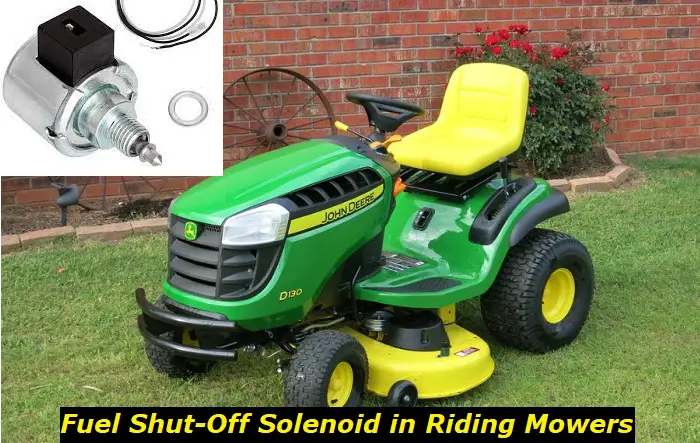Symptoms of a Bad Fuel Solenoid on a Riding Mower: Diagnosis and Maintenance
A fuel solenoid is a key component imperative to the operation of a riding mower. This mechanism controls the flow of fuel into the engine at the correct times, essentially acting as a gatekeeper. Without it, your mower can experience a myriad of issues, from sputtering at idle to an inability to start. Hence, understanding what a fuel solenoid is and why it is necessary for a riding mower is the first step towards diagnosing and rectifying potential problems.

In this article, we will guide you on how a fuel solenoid functions within a riding mower and delve into the common symptoms that indicate a faulty solenoid. Additionally, we will discuss the impacts of a bad solenoid on mower performance, including fuel efficiency and power output. Furthermore, we will provide tips for troubleshooting a fuel solenoid suspected to be faulty and detail the procedures for replacement. Regular maintenance and vigilance can prevent many of these issues from cropping up, and we aim to equip you with the requisite knowledge in this regard.
Understanding How a Fuel Solenoid Works in a Riding Mower
Settle in dear reader, we're about to delve into the heart of a riding mower, to a tiny yet essential component - the fuel solenoid. The fuel solenoid is a nifty little device that sits on the bottom of the carburetor. Its job, you might ask? It plays a vital role in controlling the flow of fuel to your mower's engine.
Like a dutiful gatekeeper, the fuel solenoid ensures that fuel only enters the engine when it's needed, specifically when the ignition key is turned on. To do this, it utilizes an electromagnet. When you turn on the ignition, electrical power is supplied to the fuel solenoid, activating the electromagnet. This in turn lifts a little pin inside the solenoid, opening a path for fuel to flow into the engine.
But that's not all. When the ignition is turned off, the electrical power is also cut off to the fuel solenoid. The electromagnet is deactivated, the pin drops back into place, and the fuel path is blocked, preventing fuel from leaking into the engine when it's not running."> /p>
By managing the ebb and flow of fuel, the fuel solenoid not only ensures your riding mower runs smoothly but also contributes to its longevity. It helps prevent flooding, which can harm the engine, and mitigates issues like fuel leakage. In short, a well-functioning fuel solenoid is key to keeping your riding mower up and running for those sunny afternoons of effortless mowing.
Common Symptoms of a Bad Fuel Solenoid
The fuel solenoid, despite being a small, seemingly insignificant component, plays a pivotal role in the functionality of your riding mower. Being familiar with its typical symptoms when malfunctioning is therefore an essential part of overall maintenance. As experienced mechanics would tell you, a keen eye and a basic understanding of these symptoms can save a great deal of hassle down the line.
One of the most common symptoms of a bad fuel solenoid is difficulty in starting the mower. If the solenoid is not letting the correct amount of fuel pass to the engine, it will inevitably cause startup problems. After all, it is the fuel solenoid's responsibility to regulate the fuel supply!
Another typical symptom of a bad fuel solenoid might be an increased fuel consumption. A faulty solenoid might leak fuel into the engine when it shouldn't be, leading to an over-fueled or 'rich' engine condition. This excess fuel usage is likely to decrease fuel economy, making your mower less efficient.
You might also experience erratic engine behavior or engine stuttering. For instance, the engine might run rough or sputter at idle, due to fluctuating fuel supply caused by the bad solenoid. In some cases, it can cause the engine to stall altogether, leading to immediate cessation of mowing operations.
A final indicator of a bad fuel solenoid is a check engine light or a fault code indicating fuel system errors. Modern mowers come equipped with onboard diagnostic systems, and a malfunctioning solenoid can often trigger codes related to fuel control or emission systems.
Remember, any abnormalities in your riding mower's operation are usually signals for attention and potentially indicate underlying issues. So always trust your instincts, perform regular checks, and act promptly at the first sign of trouble to maintain a smooth running mower.
Impact of a Bad Fuel Solenoid on Your Riding Mower
A faulty fuel solenoid can significantly disrupt the operation of your riding mower and if left unchecked, can lead to further damage and increased operating costs over time. The role of the fuel solenoid is critical in maintaining optimum performance. It dictates the flow of fuel into the engine; without it functioning correctly, your machine can't operate as efficiently as it should.
Firstly, a malfunctioning fuel solenoid can directly impact fuel efficiency. When it's not operating correctly, the balance of air and fuel mixture that enters the combustion chamber could be disrupted. This may lead to the engine running too lean or too rich, either of which is not an optimal condition for the engine and can result in decreased fuel efficiency.
Secondly, power output of your mower could also be affected by a defective solenoid. It might cause erratic idling, loss of power, and eventually, your mower could even fail to start. This is due to the disrupted fuel flow leading to an unstable combustion process, thereby affecting the engine's overall power generation.
Last but not least, other components of your engine could incur damage due to a faulty fuel solenoid. If the solenoid is stuck open or closed, it may result in the fuel being leaked into the engine even when the mower is switched off or can prevent the fuel from being delivered at the right times, respectively. Both of these occurances can lead to a multitude of issues, including but not limited to, flooding of the engine or overheating, both of which can lead to significant damage if not rectified promptly.
Considering the above points, it's clear that a functional fuel solenoid is integral to maintaining the health and performance of your riding mower. When the fuel solenoid works as it should, your machine operates smoothly, reliably, and efficiently.
Troubleshooting and Confirming a Bad Fuel Solenoid
Delving into the mechanics of your riding mower, the process of troubleshooting and confirming a bad fuel solenoid can seem complex but is in fact manageable. When you suspect that your machine is harboring a faulty fuel solenoid, a few checks can get you to the heart of the matter.
Initially, listen closely to the sounds your mower is making when you attempt to start it. A fuel solenoid in good condition will emit a distinct clicking sound, indicating it is functioning properly and allowing fuel to flow into the engine chamber. If this sound is missing or sounds irregular, it's possible that the solenoid may be faulty.
For a more concrete conclusion, employ a multi-meter. Disconnect the solenoid from your mower and connect it to the multi-meter. By sending a charge through the solenoid and monitoring its response, you can determine whether it's working correctly. An unresponsive solenoid or one that shows inconsistent readings may well be impaired.
Finally, a visual inspection can often provide clear evidence of a problem. Look for signs of wear and tear, damage, or corrosion. A solenoid is a hardworking component and these signs would be common on a part reaching its end of life. Furthermore, you should pay particular attention to the state of the wires and connections to and from the solenoid. Damaged or frayed wires can affect the solenoid's functionality.
Remember, a machine is only as strong as its weakest component. Understanding how to diagnose and confirm a faulty fuel solenoid could save you a hefty repair bill and keep your mower running smoothly for years to come.
Steps to Replace a Faulty Fuel Solenoid in a Riding Mower
Replacing a faulty fuel solenoid in a riding mower can be simple and just require some basic tools and a bit of patience. It's certainly an achievable task for any homeowner, and our comprehensive guide will help make this task even more manageable.
To kick things off, make sure the riding mower is turned off and cool to the touch. The last thing anyone wants is to work on a hot engine, as it poses both safety and comfort issues. Once you have ensured the mower is off and cooled down, disconnect the battery to prevent accidental activation while working on the machine. Safety always comes first, remember that.
Next up, locate the fuel solenoid. Its position can vary depending on the mower model, but you'll generally find it underneath the fuel bowl. If you're having trouble finding it, your mower's user manual should guide you to the correct location.
Once located, disconnect the wire that's connected to the solenoid. Loosen the bolt holding the solenoid to the carburetor using an appropriate wrench, and then carefully remove the solenoid. Remember, be gentle and patient- it is not a wrestling match.
With the old or bad solenoid removed, it's time to install the new one. Reverse the removal process - turn the new solenoid into the carburetor, tighten the bolt and reconnect the wire. Make sure everything is secured properly and tightly. The new solenoid should be fixed snuggly, but not overly tight, as over tightening can damage the component.
With the fuel solenoid replaced, reconnect the battery and start the riding lawnmower to check that everything is in order. If the mower runs smoothly, then you've successfully replaced your faulty fuel solenoid!
Remember, mechanical tasks like this require patience and care. Although it may be a bit daunting if you've never tackled anything like this before, replacing a fuel solenoid is a very doable task if followed diligently.

Add comment